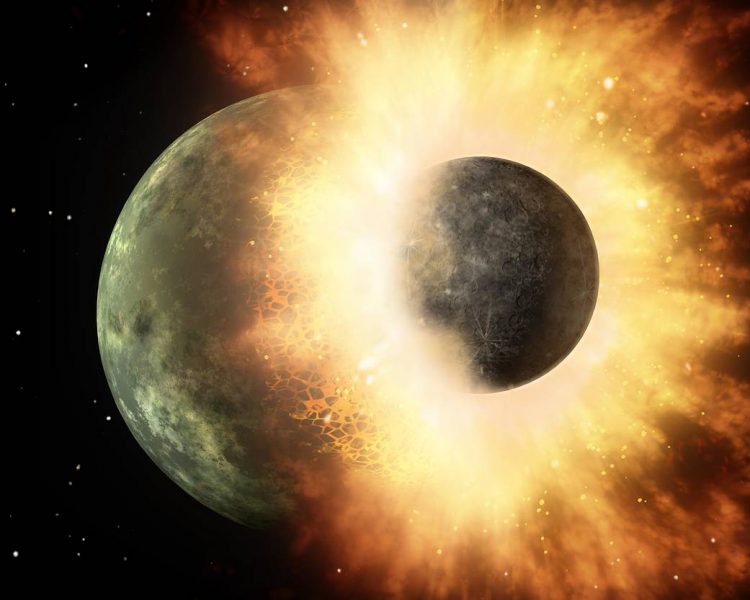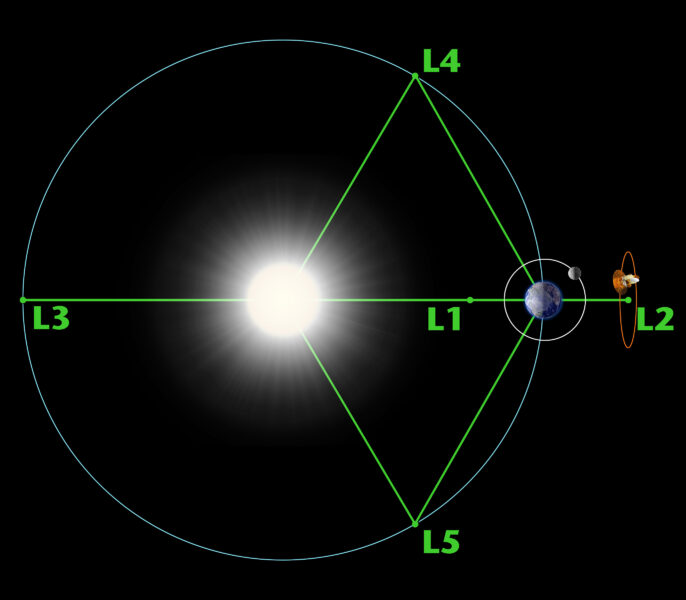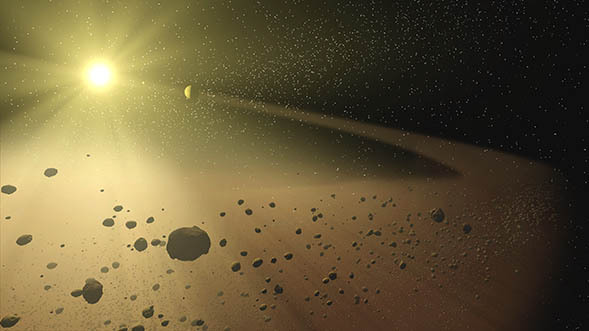Why doesn’t Earth have Trojan asteroids of its own? Large impacts in the early years of the solar system may be to blame.

Giant impacts on our newly formed planet, like the smash-up that led to the formation of the Moon, may have evicted small asteroids from stable regions in Earth’s orbit around the Sun, according to a University of Michigan team led by Kevin Napier.
Thousands of Trojan asteroids are known to populate similar stable regions in Jupiter’s orbit — the L4 and L5 Lagrange points, which are located 60° ahead and behind the planet as it goes around the Sun. Neptune and Mars also host a fair number of Trojans. In contrast, Earth’s L4 and L5 points appear to be largely empty, except for two small objects that are probably temporary denizens.

NASA / WMAP Science Team
According to Napier’s colleague Larissa Markwardt, Earth Trojans are “some of the hardest objects to study from Earth,” because they always hang out in the vicinity of the Sun from our point of view. Existing surveys indicate that there could be at most something like 100 of them larger than a few hundred meters across. But the gravitational stability of the L4 and L5 regions implies many “primordial” Trojans ought to have survived since the earlies days of Earth’s formation, when small bodies known as planetesimals filled the solar system. So where are they all?
Napier, Markwardt, and their colleagues argue that large collisions like the one that created the Moon may have been responsible. Their numerical simulations show that “such collisions can be highly disruptive to the primordial Trojan population and could have eliminated it altogether,” the authors write in a paper accepted for publication in The Planetary Science Journal (preprint available here).
As Napier explains, a giant collision can produce small changes in the shape of Earth’s orbit: both its overall size and its ovalness, or eccentricity. “These changes, in turn, destabilize the Trojans,” he says. “Several relatively small and less severe impactors also cause Earth to lose most, if not all, of its Trojans.” All in all, the authors conclude that if Earth acquired the final 1% of its mass through a dozen or so major collisions, those collisions would have unbound about 99% of the previously bound Trojans.
Then again, debris from a big collision can also end up in a stable Lagrange point. According to Markwardt, that seems to have happened in the case of Mars. However, the resulting number is much smaller than the expected number of primordial objects.

NASA / JPL-Caltech / T. Pyle (SSC)
That said, Bill Bottke (Southwest Research Institute) isn’t sure there ever was a large primordial population of Earth Trojans. He thinks growing protoplanets may have stirred up leftover planetesimals into eccentric and inclined orbits; few, if any, would have remained in the L4 and L5 regions.
“It’s not clear to me that the lack of Earth Trojans is an actual ‘problem’ per se,” Bottke says. “To make the case that their model explains why Earth Trojans are missing, [the authors] probably need to show results from a terrestrial planet formation simulation that leaves the Earth with Trojans prior to the Moon-forming event.”
A more thorough survey of the Earth’s L4 and L5 points may turn up more small members of our planet’s remaining Trojan population, which would certainly tell us more about its evolution. Markwardt is especially looking forward to NASA’s mid-infrared NEO Surveyor, slated for launch in 2026. “It’s my best bet” she says.
 2
2









Comments
Anthony Barreiro
May 2, 2022 at 6:09 pm
How does distance from the Sun affect the stability of objects at different planets' L4 and L5 points? Intuitively, it seems that a smaller orbit would be more easily perturbed than a larger orbit. Planets farther from the Sun have more moons than closer planets. Does a similar relationship hold for Trojan asteroids?
You must be logged in to post a comment.
Rod
May 3, 2022 at 9:55 am
“It’s not clear to me that the lack of Earth Trojans is an actual ‘problem’ per se,” Bottke says."
This was an interesting report. My thinking. There is abundant catastrophism now in the early solar system models. Giant impact with Theia, proto-earth mass, what was the proto-Moon initial mass after Theia, other large craters now reported from large impacts on the Moon like South-pole Aitken (SPA), etc and continued heavey bombardment taking place on Earth, some models as late as 3.5 Gyr ago in the Precambrian. Computer simulations use different amounts of total gas and dust for the MMSN too, some 3300 earth masses in the ecliptic, others could be 10x larger or even more (e.g., some protoplanetary discs seen today). Some models I read about showed at least 10 earth masses of planetesimals out past Jupiter near 10 au distance from the Sun, and some models showed 1-3 earth masses for the postulated discs inside of Mars to Mercury, others larger amounts up to 2,000 earth masses. Plenty of wiggle room here 🙂
You must be logged in to post a comment.
You must be logged in to post a comment.